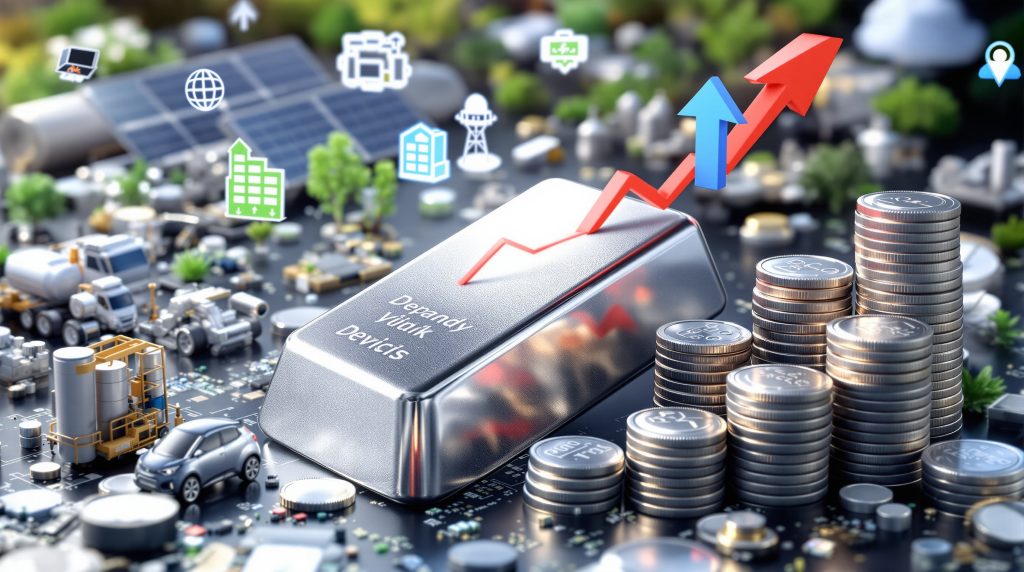The Silver Supply Deficit: Understanding Causes and Future Implications
The global silver market has been operating in a structural deficit for several consecutive years, creating significant implications for prices and investment opportunities. This imbalance between supply and demand represents one of the most compelling fundamental factors driving the precious metals market today. The persistent supply deficit in the silver market has caught the attention of investors and analysts alike, prompting deeper examination of its causes and potential outcomes.
What Defines a Silver Market Squeeze?
A supply deficit occurs when total consumption exceeds available production and recycling. In silver's case, this deficit has become increasingly pronounced, with demand outpacing supply by hundreds of millions of ounces cumulatively over recent years. This situation has created conditions that could potentially lead to a silver market squeeze impact on the broader financial ecosystem.
How Significant Is the Current Silver Supply Deficit?
The silver market has experienced a persistent supply shortfall for five consecutive years as of 2024, accumulating a deficit approaching 800 million ounces. This represents approximately 10-15% of total market demand annually, with shortfalls ranging between 100-200 million ounces each year.
Historical Context and Magnitude
While silver has experienced previous supply-demand imbalances, the current deficit is distinctive for its duration, magnitude, and persistence. Unlike previous cyclical shortages, today's deficit has extended across multiple years and represents a substantial percentage of total market demand. Perhaps most tellingly, it continues despite price increases that would typically stimulate production responses.
The total annual demand for silver currently stands at approximately 1.2 billion ounces, while mine supply provides only about 800 million ounces. Even with recycling contributing about 150 million ounces, a structural gap of roughly 250 million ounces annually remains. Understanding the gold-silver ratio analysis provides additional context for evaluating this imbalance.
What's Causing the Silver Supply Deficit?
Multiple factors are working simultaneously to create this persistent imbalance, ranging from mining constraints to surging demand across various sectors.
Mining Production Constraints
Peak Production Challenges
Global silver mine production peaked around 2016 at approximately 900 million ounces annually and has since declined by roughly 7%. This production plateau has occurred despite rising prices that would typically incentivize increased output.
Limited Mine Size
Silver mines face unique challenges related to scale. Most primary silver mines are relatively small operations with limited production capacity. As former Silver Institute Chairman Phil Baker notes, "Silver mines are small. It's very difficult to have a silver mine that's of size."
The largest silver producer globally isn't even a silver mine but rather a copper operation in Poland that produces about 40 million ounces annually. From there, production volumes drop quickly among top producers, with the seventh or eighth largest producing only around 3 million ounces.
By-Product Dynamics
Approximately 70% of silver production comes as a by-product from mines primarily focused on other metals (copper, lead, zinc, gold). This dynamic means that production decisions are often driven by the economics of the primary metal rather than silver prices.
Development Timelines
New mines require 7-10 years from discovery to production. This extended timeline creates significant lag between price signals and supply responses.
Regulatory and Construction Hurdles
Increasing environmental requirements, permitting challenges, and construction complexities extend development timelines even further, making rapid supply expansion impossible.
Investment Constraints
Historical underinvestment in exploration during previous price downturns has created a thin pipeline of new projects. As Baker points out, "There's been so little exploration that's been done over the last 30 years" in silver specifically.
Geographic Concentration Risks
Silver production is highly concentrated, with the top 10 producing countries accounting for over 90% of global output. Mexico, Peru, China, Australia, and Bolivia represent significant producers, creating vulnerability to regional disruptions.
Surging Industrial Demand
Manufacturing and Electronics Applications
Silver's unparalleled electrical conductivity makes it essential for numerous applications:
- Electronics: Circuit boards, switches, and contacts
- Automotive: Advanced driver assistance systems and electronic components
- Medical Devices: Antimicrobial properties for healthcare equipment
Despite economic fluctuations, these applications continue to grow. As Baker emphasizes: "The long-term trend is not going to change… We're going to continue to need silver for all of the industrial applications."
Green Energy Transition
The renewable energy revolution has dramatically increased silver consumption:
- Photovoltaic Cells: Each solar panel contains approximately 20 grams of silver
- Electric Vehicles: The average EV uses 25-50 grams of silver (compared to 15-28 grams in conventional vehicles)
- 5G Infrastructure: Advanced telecommunications requiring silver-based components
Baker explains that industrial demand has "more than doubled over the course of the last 25 years" even as traditional photographic demand disappeared completely.
Investment Demand Dynamics
Physical Bullion Accumulation
Investor behavior has shifted significantly toward long-term holding patterns:
- Retirement Integration: Growing allocation of silver within tax-advantaged retirement vehicles
- Inheritance Retention: Heirs increasingly retain inherited silver rather than liquidating
- Generational Asset Perspective: Physical silver now viewed as a multi-generational holding
As Baker observes, "In the past people would put silver into their IRA and they would be done. They wouldn't add to it. Now they're adding to it and they're continuously adding to it."
Regional Investment Growth
The United States represents the largest market for physical silver investment. According to a Silver Institute report from August 2024 cited by Baker, "The US is by far the biggest consumer of bars and coins. Over the course of the last 15 years, it's been about 1.5 billion ounces."
Significant demand also comes from India, where silver purchases persist despite all-time high prices in rupee terms. Baker describes this demand as "insatiable," with high-net-worth individuals investing alongside traditional buyers. This growing interest has created a need for more effective silver pricing strategies to manage market dynamics.
How Does the Paper vs. Physical Market Dynamic Impact the Deficit?
The silver market operates with distinct but interconnected segments that can send contradictory signals.
The Two-Tier Market Structure
- Paper Market: Futures contracts, options, and derivatives traded on exchanges like COMEX
- Physical Market: Actual bars, coins, and industrial-grade metal changing hands
These markets can operate with different drivers, creating disconnects that impact overall market function.
Price Volatility vs. Physical Premiums
Paper markets experience greater short-term price swings influenced by macroeconomic data, currency movements, and trader positioning. Recent examples include conflicting economic signals from jobless claims (227,000, suggesting economic strength) versus ADP Research Institute data showing 54,000 private sector job losses, indicating weakness.
Meanwhile, physical premiums—the spread between spot prices and actual product costs—provide insights into actual supply tightness. The Perth Mint in Australia reported experiencing "more demand over the course of the last five years than they had ever experienced in the history of the mint," requiring facility expansion to meet demand.
Inventory Flows and Geographic Shifts
Movement of physical metal between depositories reflects underlying demand patterns. Recent tariff concerns caused significant silver movement from London to US depositories, with "significantly less silver than you typically have in the UK." This flow continues with Indian demand pulling additional supply from the UK to satisfy consumption.
What Are the Implications for Silver Prices?
The persistent deficit creates conditions for potential price acceleration through several mechanisms. Investors watching the silver price outlook should consider these structural factors in their analysis.
Price Formation Dynamics
As deficits persist, several price factors come into play:
- Inventory Drawdowns: Visible stockpiles decline as deficits are satisfied from existing supplies
- Premium Expansion: Spreads between spot prices and physical products widen during shortage periods
- Base Building: Silver has established a solid price base "certainly above $30" according to Baker
Gold-Silver Ratio Considerations
The gold-silver ratio (the number of silver ounces needed to purchase one gold ounce) serves as a valuation metric for precious metals. Baker suggests a natural range "of 60 to 70" is appropriate, compared to recent higher levels. This implies significant potential appreciation for silver relative to gold. For those interested in understanding gold-silver markets, this ratio provides valuable insight into relative valuation.
Volatility and Price Movements
Silver is known for its price volatility, which can work to investors' advantage. Baker notes that in India, high-net-worth individuals may "invest in silver for a different reason than they invest in gold" with "an element of the volatility of silver being attractive to them in order to generate outsized returns."
Price Targets and Potential
While short-term movements remain unpredictable, the structural deficit supports higher prices. Baker predicts that silver will "exceed $50 assuming gold continues at the sort of levels that it's at" and potentially reach significantly higher levels. He suggests that at some point, "you are going to have this steep increase in the price of silver" that could potentially reach "$80 or higher."
How Is Industrial Demand Evolving?
Silver's unique properties make it difficult to substitute in many applications, driving persistent and growing industrial consumption.
Technical Properties and Applications
Silver possesses a combination of properties that make it irreplaceable in many contexts:
- Electrical Conductivity: Highest of all metals, essential for efficient energy transfer
- Thermal Conductivity: Excellent heat dissipation properties
- Reflectivity: Unmatched light reflection capabilities
- Antimicrobial Properties: Natural biocidal characteristics
Growth Sectors and Future Demand
Several industries are driving increased silver consumption with strong future growth potential:
Renewable Energy Expansion
Solar photovoltaic installations continue growing globally, with annual capacity additions more than doubling since 2018. Each gigawatt of solar capacity requires approximately 30-40 tonnes of silver, creating substantial ongoing demand.
Automotive Electrification
Vehicle electrification accelerates silver demand through:
- Production Scaling: EV manufacturing volumes growing at 25-35% annually
- Silver Content: Higher per-vehicle silver usage in electric and hybrid models
- Advanced Features: Autonomous driving systems requiring additional silver-based components
Developing World Consumption
As living standards rise globally, silver consumption increases. Baker notes, "Particularly in the developing world, as their economies, their lifestyles become more like the Western world's lifestyles, they're going to actually consume more silver."
What Role Does Investment Demand Play?
Investment demand represents a critical and growing segment of the silver market, with distinctive regional patterns and evolving buyer behavior.
Physical Bullion Trends
Retail and high-net-worth investor behavior has evolved significantly, particularly in the United States where a substantial portion flows into tax-advantaged retirement accounts (IRAs). Baker explains that this silver is held in depositories with specific allocation to individual investors.
Importantly, this silver tends to remain off-market for extended periods, with Baker noting that the 1.5 billion ounces purchased in the U.S. over 15 years "is still there" with minimal selling from long-term holders. According to the Silver Institute's supply and demand analysis, investment demand remains a key driver of the overall market balance.
Regional Variations and Market Patterns
Investment patterns differ significantly across markets:
North American Market
- Predominant Products: Government-minted coins and privately produced bars
- Retirement Allocation: Significant portion directed to tax-advantaged accounts
- Storage Preferences: Mix of home storage and professional depository services
Indian Market
India shows remarkably strong demand despite price increases, with silver serving multiple purposes:
- Silverware and Art: Traditional demand for decorative and functional items
- Investment Demand: Growing focus on silver as a wealth preservation vehicle
- Price Resilience: Continued buying despite all-time highs in local currency
How Are Mining Companies Responding?
Mining operators face challenging decisions in addressing the silver deficit, with limited immediate options for production increases.
Production and Exploration Strategies
Mining companies must balance maintaining existing operations with developing new resources:
- Capital Allocation: Previously limited exploration funding is now becoming more available
- Development Timeline: New discoveries will take "a decade or more to see mines go into production"
- Existing Mine Expansion: Companies like San Crystal Mining continue exploration at producing mines to extend mine life
Industry Challenges and Opportunities
The mining sector faces both constraints and potential opportunities:
- Historical Underinvestment: Limited exploration over the past 30 years creates both a supply gap and future opportunity
- Improved Funding Environment: Baker notes "access to capital for the explorers that you just didn't have a year ago"
- Production Timeline Realities: Despite improved market conditions, the lag between discovery and production remains substantial
What Are the Global Implications?
The persistent supply deficit in the silver market has broader implications for industrial users, government policy, and market structure.
Supply Chain Security and Industrial Response
Industrial users are beginning to reassess procurement strategies in response to tightening supplies and potential critical mineral designation:
- Inventory Management: Potential shift from just-in-time to strategic stockpiling
- Supply Security: Major users like Tesla may need to "rethink how they manage that silver"
- Strategic Planning: Companies becoming less willing to operate with minimal silver inventory
Critical Mineral Designation Potential
Governmental recognition of silver's strategic importance is growing, with Baker noting that "silver will be considered a critical mineral" following the current comment period. This designation would further elevate the metal's importance in industrial and strategic planning.
Market Structure Evolution
The relationship between physical and paper markets continues to evolve, with physical constraints increasingly influencing price formation. Geographic flow shifts, such as movement from London to US depositories due to tariff concerns, demonstrate the complex interplay between regulations, logistics, and market pricing.
What Does the Future Hold for the Silver Market?
The silver market faces both challenges and opportunities as it navigates the persistent deficit environment.
Supply Response Timeline
Addressing the deficit requires significant lead time due to:
- Project Development: 5-10 years from discovery to production for new mines
- Exploration Cycle: Current exploration will take years to yield production
- Limited Scale Options: The relatively small size of silver mines limits rapid expansion potential
Risk-Reward Analysis for Investors
The current market structure creates a favorable risk-reward profile according to Baker:
- Limited Downside: "The downside risk seems very very low" barring a severe financial crisis
- Upside Potential: Possibility for significant price appreciation beyond previous highs
- Patience Requirement: "This is not a game for a really short-term view" but "when it happens, it moves dramatically"
Price Support Factors
Multiple factors provide underlying support for silver prices:
- Geopolitical Tensions: Events like the Russia-China-India summit, conflicts in Ukraine and Gaza
- Economic Uncertainty: Tariff concerns and domestic economic challenges
- Monetary Policy: Potential interest rate cuts by the Federal Reserve
- Base Building: Establishment of price support above the $30 level
Frequently Asked Questions
How long can a supply deficit continue before prices dramatically respond?
Markets can sustain imbalances for extended periods before reaching inflection points. Historical precedent suggests that silver deficits typically trigger significant price responses when visible inventories reach critically low levels or when external catalysts (economic crises, currency devaluations, or supply disruptions) coincide with existing structural shortages.
Could substitution or thrifting eliminate the deficit?
While manufacturers continuously seek to reduce silver content (thrifting) or find alternatives (substitution), these efforts face physical limitations. Silver's unique properties make complete replacement impossible in many applications, and efficiency improvements eventually reach diminishing returns. These efforts may moderate demand growth but are unlikely to eliminate the structural deficit entirely.
How do central bank policies affect the silver deficit?
Monetary policies influence silver markets through multiple channels:
- Interest Rates: Lower rates reduce opportunity costs of holding non-yielding assets like silver
- Currency Values: Dollar weakness typically supports higher silver prices
- Inflation Expectations: Anticipated purchasing power erosion enhances silver's appeal as a store of value
What role does China play in the global silver market?
China influences the silver market as:
- A major producer (ranking third globally)
- The world's largest industrial consumer
- A significant fabricator of silver products
- An expanding market for investment demand
- A key manufacturer of silver-intensive solar panels
How does the gold-silver ratio relate to the deficit?
The gold-silver ratio (the number of silver ounces needed to purchase one gold ounce) often serves as a valuation metric. During periods of persistent silver deficits, this ratio typically contracts as silver outperforms gold. Historical averages suggest a ratio between 40:1 and 60:1 during balanced markets, compared to recent levels above 70:1, potentially indicating undervaluation of silver relative to gold.
Is the current deficit likely to be resolved soon?
The combination of rising demand and constrained supply makes near-term resolution of the deficit unlikely. Even with improved exploration funding, the development timeline for new mines extends 7-10 years. Meanwhile, industrial and investment demand continue to grow, creating a persistent structural imbalance for the foreseeable future.
What scenarios could lead to significant price declines in silver?
Baker identifies a few scenarios that could temporarily pressure silver prices:
- A broad-based financial crisis forcing liquidation across asset classes
- Sharp decline in industrial demand due to severe economic contraction
- Investors needing to liquidate precious metals to cover shortfalls elsewhere
However, he emphasizes that even in these scenarios, the downside appears limited given the established price base and ongoing deficit conditions.
How are miners adjusting their exploration strategies?
Mining companies are beginning to increase exploration spending after years of underinvestment. With improved access to capital, explorers can now undertake basic exploration necessary to identify new deposits. However, the industry faces a significant lag between current exploration and future production, with Baker noting it will "take a decade or more to see mines go into production."
Ready to Catch the Next Major Silver Price Move?
Don't miss potential investment opportunities from the ongoing silver supply deficit – Discovery Alert's proprietary Discovery IQ model delivers real-time alerts on significant mineral discoveries across the ASX, including silver explorers. Visit our discoveries page to understand how major mineral discoveries can lead to substantial returns and begin your 30-day free trial today.




